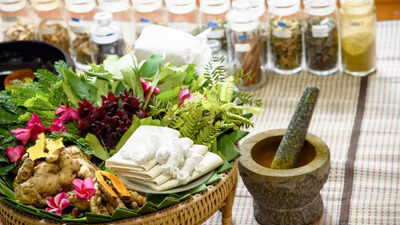In the age of holistic health and traditional medicine, India’s herbal value chains, particularly in the Ayurvedic sector, offer a compelling example of how smallholder cultivators and global markets are interconnected.From a village farmer cultivating Tulsi or Ashwagandha to an international wellness brand selling herbal supplements, every stage adds value to the process. Yet, the journey is not just about trade – it’s about sustainability, livelihood, and the preservation of an ancient heritage.
The cultivation and harvesting segment
At the root of the value chain are rural growers and forest collectors who supply the raw herbs. India is home to over 1,200 medicinal plant species used in Ayurveda, Siddha, and Unani systems.
Election Results 2025
Many of these plants are still collected from the wild, though the trend toward cultivation is increasing due to the growing herbal demand. Cultivation provides both livelihood security and ecological balance, ensuring that endangered species are protected while meeting industrial requirements.
Processing, value addition, and formulation

Credit: Canva
Once harvested, the herbs move through stages of cleaning, drying, extraction, and formulation into powders, oils, or tablets.This stage brings significant value addition, transforming low-cost raw herbs into high-value Ayurvedic formulations. However, small cultivators often receive minimal profits compared to downstream processors and manufacturers. Quality control is another key challenge; adherence to Good Agricultural Practices (GAP) and Good Manufacturing Practices (GMP) is essential for global acceptance.Proper standardisation ensures safety, potency, and authenticity; key factors that uphold Ayurveda’s reputation worldwide.
Global and domestic market linkages
The demand for herbal and Ayurvedic products has surged globally. Leading Ayurvedic enterprises such as Patanjali Ayurved demonstrate how village-based cultivation, modern manufacturing, and international marketing can integrate effectively within one value chain; turning ancient knowledge into global wellness solutions without losing its traditional essence.
Challenges in the value chain
Despite its promise, the herbal value chain faces multiple obstacles.Many cultivators lack access to organised markets, certification, and fair pricing mechanisms. Wild collection often remains unregulated, leading to quality inconsistencies and ecological strain. Storage and logistics challenges further limit shelf life and export readiness. Fragmentation across the chain, from farmers to processors, results in uneven profit distribution.Addressing these bottlenecks requires cooperation between farmers, research institutions, policymakers, and the private sector to ensure fair, sustainable, and traceable supply systems.
Opportunities and the way forward
To strengthen the herbal value chain, several strategies can make a lasting difference:Vertical integration: Linking cultivators directly with processors to ensure equitable profit distribution.Certification and training: Supporting farmers with knowledge of organic cultivation and quality assurance.Sustainability: Encouraging cultivation over wild harvesting to protect biodiversity.Traceability systems: Building end-to-end transparency from field to finished product to meet global standards.By promoting these interventions, India can elevate its herbal industry from fragmented local trade to a globally recognised wellness network rooted in Ayurveda.The journey of an Ayurvedic herb, from a small village farm to a global wellness shelf – represents both opportunity and responsibility. The herbal value chain not only sustains rural livelihoods but also carries India’s ancient wisdom into the modern age. In an era where health and sustainability converge, strengthening the herbal value chain ensures that Ayurveda continues to serve humanity – naturally, ethically, and globally.

